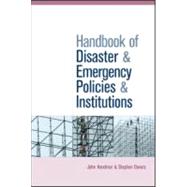
Note: Supplemental materials are not guaranteed with Rental or Used book purchases.
Purchase Benefits
What is included with this book?
| List of Figures, Tables and Boxes | p. viii |
| Acknowledgements | p. x |
| List of Acronyms and Abbreviations | p. xii |
| Introduction: The Context and Aims of this Book | p. xiv |
| Constructing the Problem | p. 1 |
| The Nature of Emergencies and Disasters | p. 3 |
| Overview of disaster trends | p. 5 |
| Emergency and disaster institutions | p. 6 |
| The nature of disasters and emergencies: Cause and effect | p. 8 |
| Evolution of emergency management: From 'acts of God' to socially constructed disasters | p. 11 |
| Illustrative vignettes | p. 14 |
| Key challenges | p. 25 |
| The Nature of Policy and Institutions | p. 29 |
| Core concepts and terms | p. 31 |
| Traditions and trends in policy analysis | p. 33 |
| Policy styles and the political environment | p. 41 |
| Emergencies and disasters as policy and institutional problems | p. 43 |
| Reconciling policy with emergencies and disasters | p. 45 |
| Constructing the Response | p. 47 |
| A Policy and Institutional Framework for Emergencies and Disasters | p. 49 |
| Policy cycles meet emergency risk management | p. 49 |
| A framework for policy and institutional analysis | p. 53 |
| Using the framework | p. 56 |
| Owning the Problem: Politics, Participation and Communication | p. 59 |
| Policy and politics | p. 59 |
| Who? Defining 'community' | p. 60 |
| Why? Purposes and degrees of participation | p. 64 |
| How? Options for community engagement | p. 69 |
| Communication: The lifeblood of participation | p. 76 |
| Communication challenges | p. 79 |
| Conclusion | p. 80 |
| Framing the Problem: Identifying and Analysing Risk | p. 83 |
| Problem framing | p. 83 |
| Cause-effect linkages | p. 86 |
| Pervasive uncertainty | p. 89 |
| Attributes of emergency management policy problems | p. 91 |
| A typology of disasters and emergencies | p. 93 |
| Routine | p. 94 |
| Non-routine | p. 94 |
| Complex emergencies | p. 95 |
| The risk standard | p. 97 |
| Hierarchy of goals, issues and problems | p. 100 |
| Conclusion | p. 101 |
| Responding to the Problem: Policy Formulation and Implementation | p. 103 |
| Broad policy choice: Generic resilience or specific instruments? | p. 103 |
| Generic approaches to hazards management | p. 105 |
| Specific approaches to hazards management | p. 106 |
| For crisis response: Flexibility and adaptability | p. 107 |
| Policy problems and policy instruments | p. 109 |
| Policy instruments and styles for implementation | p. 110 |
| Policy styles and attributes required for implementation | p. 116 |
| Implementation attributes | p. 120 |
| Conclusion | p. 122 |
| Not Forgetting: Monitoring, Evaluation and Learning | p. 125 |
| Uncertainty, time and learning | p. 125 |
| Policy and institutional learning: Purposes and forms | p. 128 |
| Basic information capture | p. 136 |
| Evaluation: The precondition for learning | p. 137 |
| Research and education | p. 140 |
| Prospects for learning | p. 142 |
| Institutional Settings for Emergencies and Disasters: Form, Function and Coordination | p. 145 |
| Institutions: The key to common endeavours | p. 145 |
| Institutions and emergencies: Status and issues | p. 148 |
| Purpose, form and principles | p. 155 |
| Learning, law and liability | p. 158 |
| Conclusion | p. 159 |
| Constructing the Future | p. 161 |
| Future Prospects | p. 163 |
| How disastrous a future? | p. 163 |
| Key challenges | p. 167 |
| Prospects: Anticipation, resilience and adaptation | p. 169 |
| References | p. 171 |
| Index | p. 179 |
| Table of Contents provided by Ingram. All Rights Reserved. |
The New copy of this book will include any supplemental materials advertised. Please check the title of the book to determine if it should include any access cards, study guides, lab manuals, CDs, etc.
The Used, Rental and eBook copies of this book are not guaranteed to include any supplemental materials. Typically, only the book itself is included. This is true even if the title states it includes any access cards, study guides, lab manuals, CDs, etc.